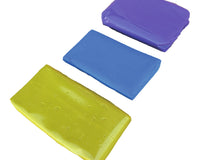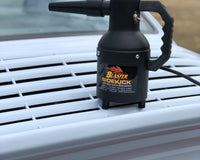As electric vehicles continue to grow in popularity, owners are becoming more aware of the importance of proper maintenance beyond the traditional cleaning of paintwork, wheels, and interiors. One often overlooked area is the charging port and its immediate surroundings. Unlike a fuel filler cap on a petrol or diesel car, an EV’s charging port is a sensitive electrical interface that must remain clean and free from contamination to ensure safe and efficient charging. Dirt, dust, water, or debris in this area can compromise the quality of the connection, slow down charging speeds, or, in rare cases, lead to malfunctions.
When left neglected, contaminants can build up around the charging flap, hinge, and sealing surfaces, allowing moisture or grit to find their way inside. This not only poses a risk to charging efficiency but can also degrade the protective seals that prevent water ingress. A dirty or corroded port can become more difficult to use over time, potentially leading to unnecessary repair costs. For EV owners who value both safety and vehicle longevity, adopting safe detailing practices for the charging port and its surroundings is essential.
Safety Considerations Before Starting
Before attempting to clean the charging port area, safety must always come first. Unlike conventional detailing tasks, you are dealing with a sensitive electrical interface that must be handled with extra care. The first step is to make sure the vehicle is switched off and not actively charging. Never attempt to clean the port while it is connected to a charger, as this increases the risk of electrical short circuits.
Using the right products is another key safety measure. Harsh cleaners, petroleum-based solvents, or highly acidic chemicals can damage protective seals, corrode connectors, or leave residues that interfere with conductivity. Instead, mild cleaners specifically formulated for automotive detailing, along with pH-neutral products, should be used. Equally important is avoiding excessive moisture. High-pressure water sprays or aggressive steam cleaners can force water into sensitive areas, leading to corrosion or electrical damage. Always aim for controlled, gentle cleaning with minimal liquid exposure.
Tools and Products You’ll Need
To detail the charging port and its surroundings safely, having the right tools and products makes the job more efficient and less risky. Microfibre cloths are essential for wiping down surfaces without scratching the paint or plastic trim around the port. A set of soft detailing brushes or foam swabs can be used to reach into tight corners around the hinge and port frame. For cleaning solutions, a pH-neutral all-purpose cleaner diluted appropriately is ideal for removing dirt and grime without leaving harmful residues.
A small bottle of isopropyl alcohol (IPA) solution is also recommended for gently cleaning the metal contacts of the charging port, but only in very small amounts and with extreme caution. Dielectric grease or protective sprays formulated for electrical components can be applied sparingly to help prevent future corrosion. Finally, a handheld air blower or compressed air can be extremely useful for drying the area without leaving behind moisture. Investing in the right tools ensures that the cleaning process is safe, effective, and avoids unnecessary wear on sensitive components.

Step-by-Step Guide to Cleaning the EV Charging Port Surroundings
Step 1: Exterior Cleaning Around the Port
Start by addressing the area surrounding the charging flap. Spray a diluted all-purpose cleaner onto a microfibre cloth and gently wipe around the edges, hinge, and surrounding paintwork. Use a detailing brush to dislodge trapped dirt in the hinge and sealing grooves. This prevents grit from being dragged into the port itself when opening and closing the flap. Make sure to clean the weather seal around the port carefully, as this is the first line of defence against water ingress.
Step 2: Inspect the Port for Contamination
Once the surrounding area is clean, carefully open the charging flap and inspect the charging port. Look for any visible dust, dirt, or signs of corrosion. If the port appears clean, it may not require extensive detailing, as over-cleaning can cause unnecessary wear. However, if contaminants are present, proceed carefully with targeted cleaning.
Step 3: Gentle Cleaning of the Charging Port
Dip a foam swab in a small amount of IPA solution and gently wipe the inside of the port contacts. Avoid saturating the swab or allowing liquid to pool inside the port. The goal is to remove any fine dirt, oils, or residues without introducing excess moisture. Never use metallic brushes or abrasive tools, as these can damage the connectors and compromise conductivity. Work slowly and with light pressure, ensuring the swab remains clean throughout the process.
Step 4: Drying and Protection
After cleaning, use compressed air or a low-powered air blower to remove any residual moisture or cleaning solution. Allow the port to air dry fully before reconnecting a charging cable. If the vehicle is stored in a humid environment, applying a very light coating of dielectric grease to the edges of the contacts may help protect against corrosion. Be extremely cautious not to over-apply, as too much product can interfere with charging performance.
Common Mistakes to Avoid
Many EV owners make the mistake of treating the charging port like any other car component during cleaning, leading to potential issues. One common error is using too much water or high-pressure washing directly into the port area, which risks forcing moisture into the electronics. Another mistake is using household cleaning products or lubricants not designed for automotive use, which can leave behind residues harmful to electrical contacts.
Aggressive scrubbing with abrasive tools is also a frequent problem. While it may remove dirt, it risks scratching delicate metal surfaces, reducing their ability to form a strong electrical connection. Similarly, failing to dry the port thoroughly after cleaning can lead to corrosion over time. Understanding these mistakes and actively avoiding them is key to keeping the charging port safe and functional.
Preventive Care for Long-Term Maintenance
Detailing the charging port is not just about cleaning when dirt builds up but also about taking preventive measures to reduce contamination. Always ensure that the charging flap is closed securely after use to keep out dust, rain, and road debris. Regularly inspect the rubber seals around the flap for signs of wear, as damaged seals allow water ingress. For vehicles used in harsh climates or dusty environments, more frequent inspections and light cleanings may be required.
Another smart preventive step is to keep the charging cable and connector clean. A dirty charging connector can transfer debris into the port, undoing your detailing efforts. Wiping the connector regularly with a dry microfibre cloth helps prevent cross-contamination. Incorporating these simple habits into your EV maintenance routine keeps the charging system reliable and extends the lifespan of both the port and the cable.
Conclusion: Safe and Effective EV Charging Port Detailing
As electric vehicles continue to evolve, so too must the detailing practices that keep them in top condition. The charging port is one of the most important yet sensitive areas of an EV, and cleaning it requires a careful balance of thoroughness and restraint. By using the right tools, mild cleaning solutions, and controlled techniques, you can safely remove dirt and contaminants without risking damage to the electrical components.
Avoiding common mistakes such as over-wetting, using harsh chemicals, or scrubbing too aggressively ensures that the port remains safe and fully functional. Combining cleaning with preventive measures, such as keeping connectors clean and checking seals regularly, helps maintain long-term charging performance. For EV owners who care about both appearance and reliability, learning to detail the charging port and its surroundings safely is a crucial step in modern car care.




